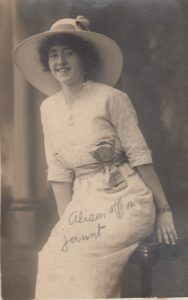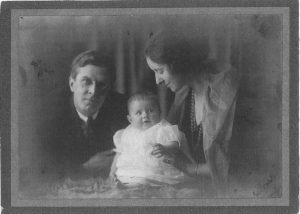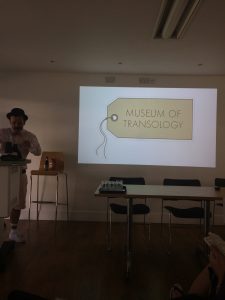History of Design and Material Culture MA graduate (2014) Ilaria Coser on being published in academic journal Fashion Theory

Alison Settle, Editor of Vogue, early 1930s. Handwritten note at the back of the photograph states: “Alison at her desk, Editor’s room, Vogue, with dolls house in background”. (courtesy of Alison Settle Archive, University of Brighton Design Archives).
A few months ago my article on the diaries of Alison Settle was published in Fashion Theory. It felt like a great accomplishment, fulfilling an aspiration I had held since the completion of my dissertation on the great British journalist and editor of British Vogue. Today, Alison Settle is virtually unknown outside fashion circles, with no auto/biography or other literature about her life and her achievements in fashion journalism. Settle reported on “women’s topics” for over 50 years, mostly in British magazines and newspapers. She was an advisor to the British textile and retail industries, and was a member of government bodies tasked with improving post-war British design. For nearly a decade between the Wars, Settle was also the editor of British Vogue, a position which required her to be actively involved with the smart set of London Society.

“Alison Off on a Jaunt,” 1915. Private photograph from the Charles Wakefield Private Archive. Permission obtained from Charles Wakefield.
My dissertation focused on the personal diaries written by Settle in the early 1930s, during the last four years of her Vogue editorship. The diaries had been preserved and cared for by Settle’s descendants, particularly by her grandson Charles, who lives in Canada. Charles was incredibly supportive and generous in sharing material and information, and I corresponded frequently with him and established a friendly collaboration. I also drew on material held in Settle’s collection at the University of Brighton Design Archives. As my research progressed, I grew increasingly invested in making Alison Settle’s name more widely known in the public domain – not only because her stature deserves recognition, but also because this would mean a lot to her family.
Fashion Theory’s theoretical and critical approach to fashion has made it my favourite academic journal throughout my studies in dress history. When my tutor, Professor Lou Taylor, mentioned that my MA dissertation had the potential to be published, Fashion Theory was my first choice. I knew that my research was a good fit for the journal, as it focused on Settle’s bodily presence as a key to access the knowledge required of her to be the editor of Vogue.
The process for publication was straightforward. Firstly, I searched online the requirements for submission. Fashion Theory is now published by Taylor & Francis, and their website hosts a very clear section for authors, detailing all the key steps. Having gathered all the practical information – word count, referencing style, recommended font, and so on – I identified a few published articles with similar characteristics to my research. Reading them provided a compass to establish which parts should be kept and which should be discarded, given that my dissertation would have to be reduced to a third of its original word count.

Alison Settle with husband Alfred and daughter Maggie, 1921. Private photograph from the Charles Wakefield Private Archive. Permission obtained from Charles Wakefield.
The re-writing of my text took longer than I expected. I had done a huge amount of detailed research on Settle’s life and I had been very selective on which parts should be included in my dissertation; for the article, I had to focus even more on the theoretical and critical aspects. Once I felt satisfied with the final draft, Professor Lou Taylor was kind enough to read it and confirm it was ready, as well as following up my submission by writing to Valerie Steele (the editor-in-chief of Fashion Theory) to introduce me and my research.
Articles are subject to peer review, and I was surprised at how quickly I received feedback. I made most of the changes recommended by the reviewer and submitted my new draft, together with a point-by-point explanation of the suggestions I had implemented and those I had opted not to apply. For example, the reviewer had suggested cutting out Settle’s biography. However, I strongly believed that it would be important to keep it, because of the complete lack of information published on her life. So, although reduced, the chapter remained.
The article was approved for publication, which happened very quickly. I was contacted by a team who supervised the proofreading and editing, requiring me to revise the text in detail and authorise further changes – changes related to syntax and grammar rather than content. And a couple of days after approving the final proof, I received confirmation that the article was published, with tips on how to broadcast the information as widely as possible.
Overall, I feel that an essential aspect of getting published was the support I received from my tutor – first hearing that my work was worthy of publication, and then her advocacy on my behalf when I submitted it to the journal. It is very satisfying to know that now there is research published on Alison Settle. Through the laborious task of transcribing her journals, I had looked into names and places and events that made it possible for me to understand the complex web of relationships in her life, and through those, her personality and values. Of course I retain my research notes and findings, and the idea of one day writing, or contributing to the writing of her biography remains my ambition.
Link to article: Ilaria Coser (2017) ‘Alison Settle, Editor of British Vogue (1926–1935): Habitus and the Acquisition of Cultural, Social, and Symbolic Capital in the Private Diaries of Alison Settle’, Fashion Theory, DOI: 10.1080/1362704X.2017.1371982





















